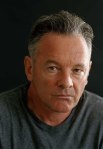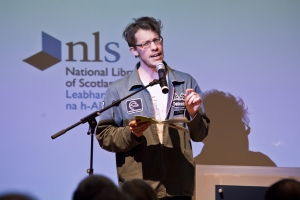The final night of StAnza always comes too quickly. The Sunday night reading is the highlight of the festival, an apogee, and yet the experience is bittersweet, for afterwards there will be no more StAnza 2013 to experience. This year though, the occasion was also touched with a real sense of triumph, for it had become clear that the festival was not just one of our best, but the best, this despite the challenges faced by the closure of our hub venue.
The finale saw the pairing of two supremely evocative poets Paula Meehan and Robin Robertson. The reading took place, as did many of our events, in the Town Hall Auditorium, transformed for the duration of the festival by wonderful lighting (courtesy of the former Byre Theatre staff) by the artwork of Lucilla Sim and, by replicas of two large woven grass works by outsider artist Angus McPhee. These two were hung above the stage, prompting much speculation about their meaning, and taking on new interpretations thanks to our imaginative audience. You can see them in the picture above and (on the right) is a chandelier made by Lucilla out of used tickets from last year’s festival.
 Paula Meehan is one of the most distinguished poets currently writing in Ireland. You can get a sense of the intensity and universality of her writing in one of the poems she read that also appears on our website: Diamond Faceted, His Breath, which deals with the death of her father. Meehan tackles these and other experiences with grace, humour and acute observation. Last night she read some new poems, some from her most recent book, Painting Rain and others from her seminal works of the Nineties. True to the theme of Legacy & Place, Meehan’s Dublin strides through her work, as strong a character, almost, as her father and her grandmother – the latter remembered in one poem as a voice whispering warnings about the proclivities of priests. She tackles the legacy of a tough childhood in a working class area of north Dublin. In one moving and strongly rhythmic poem she described the effort involved in remaining sober, day after day. Meehan talked also about the wounding experiences Ireland has undergone during the recent recession, and of her own personal journey from a difficult childhood to her achievements through education and literature. Both are somehow connected in the richness and undercurrents of rage in her poems. One of the most memorable images I came away with, however, was of a book hanging high in the branches of a tree, something she saw one day, out walking in the Georgian splendour of Merrion Square. A reminder to keep looking up indeed.
Paula Meehan is one of the most distinguished poets currently writing in Ireland. You can get a sense of the intensity and universality of her writing in one of the poems she read that also appears on our website: Diamond Faceted, His Breath, which deals with the death of her father. Meehan tackles these and other experiences with grace, humour and acute observation. Last night she read some new poems, some from her most recent book, Painting Rain and others from her seminal works of the Nineties. True to the theme of Legacy & Place, Meehan’s Dublin strides through her work, as strong a character, almost, as her father and her grandmother – the latter remembered in one poem as a voice whispering warnings about the proclivities of priests. She tackles the legacy of a tough childhood in a working class area of north Dublin. In one moving and strongly rhythmic poem she described the effort involved in remaining sober, day after day. Meehan talked also about the wounding experiences Ireland has undergone during the recent recession, and of her own personal journey from a difficult childhood to her achievements through education and literature. Both are somehow connected in the richness and undercurrents of rage in her poems. One of the most memorable images I came away with, however, was of a book hanging high in the branches of a tree, something she saw one day, out walking in the Georgian splendour of Merrion Square. A reminder to keep looking up indeed.
 Like Meehan, Robin Robertson is adept at evoking places and universal human experiences, albeit extreme ones. As he himself joked during his reading, his themes are assumed to be ‘drink, sex and death, in that order.’ His dark vision seems to be even darker in the selection of poems from his new book, Hill of Doors. There were preoccupations with Greek mythology, especially Dionysus. There were bears, a cat in the throes of death whose ‘face I see has turned human’, balladic tragedies of murder and death in bleak landscapes of mountains and lakes. He, like Meehan, like evoked his own childhood – most memorable was the image of feeding a bonfire with a Salvation Army picture of Jesus. A child of the manse, he linked his own past memories with the hymn tune Crimond, written by a teenage minister’s daughter in the 1850s, and asked ‘what softness brought this tune from your hands?’ Outstanding too was a visceral recollection of undergoing heart surgery. He finished the reading, scarcely marred by his hoarseness, the result he said of a ‘Strindbergian flu’ with the ever powerful ‘At Roan Head’. For all the darkness in this powerful reading, there was a glimmer of hope, best expressed in ‘Glass of Water and Coffee Pot’ (about a Chardin still life): ‘happiness of the hand and heart/to keep its sweetness and still pour true.’
Like Meehan, Robin Robertson is adept at evoking places and universal human experiences, albeit extreme ones. As he himself joked during his reading, his themes are assumed to be ‘drink, sex and death, in that order.’ His dark vision seems to be even darker in the selection of poems from his new book, Hill of Doors. There were preoccupations with Greek mythology, especially Dionysus. There were bears, a cat in the throes of death whose ‘face I see has turned human’, balladic tragedies of murder and death in bleak landscapes of mountains and lakes. He, like Meehan, like evoked his own childhood – most memorable was the image of feeding a bonfire with a Salvation Army picture of Jesus. A child of the manse, he linked his own past memories with the hymn tune Crimond, written by a teenage minister’s daughter in the 1850s, and asked ‘what softness brought this tune from your hands?’ Outstanding too was a visceral recollection of undergoing heart surgery. He finished the reading, scarcely marred by his hoarseness, the result he said of a ‘Strindbergian flu’ with the ever powerful ‘At Roan Head’. For all the darkness in this powerful reading, there was a glimmer of hope, best expressed in ‘Glass of Water and Coffee Pot’ (about a Chardin still life): ‘happiness of the hand and heart/to keep its sweetness and still pour true.’
And so to the finale party and a farewell to StAnza 2013 – the festival that almost didn’t happen – but it did and what a festival it has been. In her final introduction, Eleanor Livingstone thanked the supporters, funders, partners and friends, the team from the Byre Theatre who helped us enormously, the participants, the StAnza team, and most of all the audience who kept the faith through the recent crisis.
Thanks to all who contributed to this blog before and during StAnza, and to all who have been following it. Keep following – we have more to say and show in the next week or so about the festival.
Annie Kelly

















